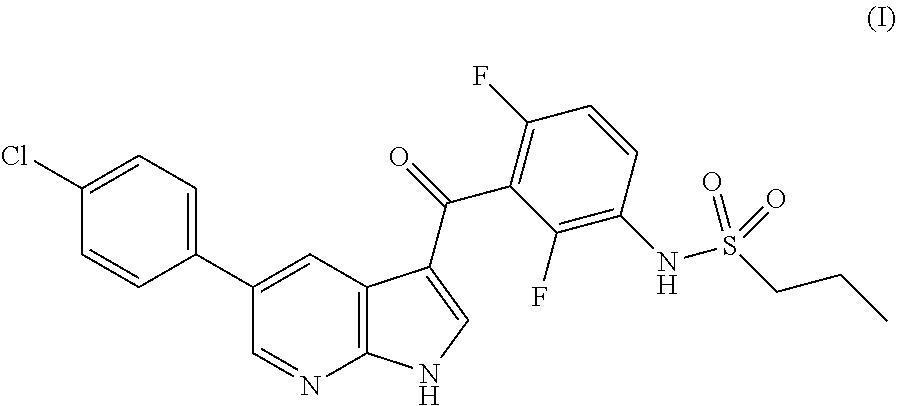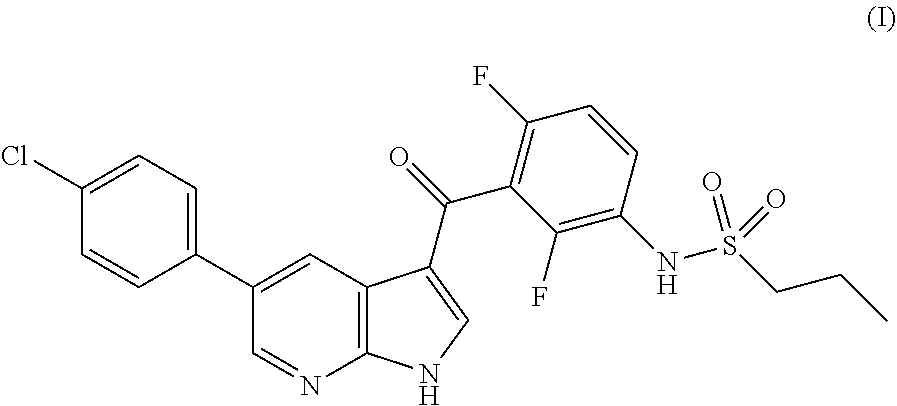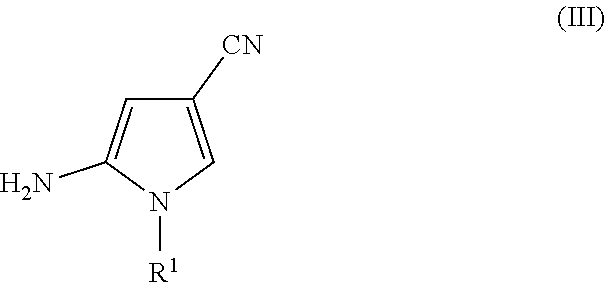New processes for the preparation of vemurafenib
- Summary
- Abstract
- Description
- Claims
- Application Information
AI Technical Summary
Benefits of technology
Problems solved by technology
Method used
Image
Examples
example 1
on of 5-amino-1-(tert-butyl)-1H-pyrrole-3-carbonitrile
[0067]To a 1 L three-necked flask equipped with a mechanical stirrer and nitrogen inlet was loaded toluene (350 mL) and potassium t-butoxide (72.0 g, 0.64 mol) at 25° C. while stirring. The suspension was cooled to 0-5° C. A solution of succinonitrile (50.0 g, 0.62 mol) and ethyl formate (54.64 g, 0.74 mol) in toluene (150 mL) was added slowly, maintaining internal temperature at 0-5° C. The mixture was let warm to 24° C. and stirred for 2 hours. To the mixture were added tert-butylamine (46.0 g, 0.63 mol) and AcOH (44.0 g, 0.73 mol). The internal temperature of the mixture rose to 40° C. upon this addition. The mixture was heated to 85° C. and stirred for 2.5 hours, and the reaction progress was monitored by GC. Upon completion, the mixture was cooled to 50-55° C. and potassium hydroxide (50 g, 0.89 mol) was added to the reaction mass. The mixture was stirred at this temperature for 16 hours, until GC showed completion of reacti...
example 2
on of 5-bromo-1-(tert-butyl)-1H-pyrrolo[2,3-b]pyridine-3-carbonitrile
[0068]To a 500 mL flask equipped with a mechanical stirrer, a reflux condenser and a nitrogen inlet was loaded anhydrous MeOH (250 mL) followed by 5-amino-1-(tert-butyl)-1H-pyrrole-3-carbonitrile (50 g, 0.31 mol) and bromomalonaldehyde (50.8 g, 0.34 mol), and the mixture was stirred at room temperature. To the solution was added p-toluenesulfonic acid (11.65 g, 0.061 mol), and the reaction was heated to 60° C. and stirred for 6 hours. Upon completion, the reaction mass was cooled to 0-5° C. The solids were filtered, washed with cold MeOH and dried under vacuum to give the title compound as a white solid (40 g, 47%). 1H NMR (300 MHz, DMSO-d6, 2.50 ppm): δ 8.58 (s, 1H), 8.52 (d, J=2.3 Hz, 1H), 8.37 (d, J=2.3 Hz, 1H), 1.74 (s, 9H). 13C NMR (75 MHz, DMSO, 40.0 ppm): δ 145.37, 144.62, 137.89, 130.10, 122.74, 115.25, 113.90, 81.90, 59.27, 28.93.
example 3
on of 5-(4-chlorophenyl)-1-(tert-butyl)-1H-pyrrolo[2,3-b]pyridine-3-carbonitrile
[0069]To a 500 mL flask equipped with mechanical stirrer, reflux condenser and a nitrogen inlet were loaded toluene (228 mL) and water (228 mL) followed by 5-bromo-1-(tert-butyl)-1H-pyrrolo[2,3-b]pyridine-3-carbonitrile (38 g, 0.14 mol), 4-chlorophenylboronic acid (30 g, 0.19 mol) and sodium carbonate (31.8 g, 0.30 mol). The suspension was degassed with nitrogen gas for 1 hour, after which to the mixture was added Pd(dppf)Cl2.CH2Cl2 complex (0.99 g, 0.0012 mol). The mixture was again degassed for 1 hour, and then heated to 85° C. for 5 hours. Upon completion the mixture was cooled to room temperature and the layers were allowed to separate. The organic layer was filtered through Celite and concentrated to give the crude product, which was triturated with petroleum ether (190 mL) followed by slurrying in 10% EtOAc in petrol ether at room temperature. The solids were filtered and dried under vacuum to give...
PUM
 Login to View More
Login to View More Abstract
Description
Claims
Application Information
 Login to View More
Login to View More - R&D
- Intellectual Property
- Life Sciences
- Materials
- Tech Scout
- Unparalleled Data Quality
- Higher Quality Content
- 60% Fewer Hallucinations
Browse by: Latest US Patents, China's latest patents, Technical Efficacy Thesaurus, Application Domain, Technology Topic, Popular Technical Reports.
© 2025 PatSnap. All rights reserved.Legal|Privacy policy|Modern Slavery Act Transparency Statement|Sitemap|About US| Contact US: help@patsnap.com



